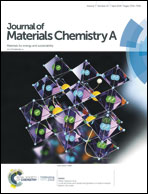Structure–property relationship of metal–organic frameworks for alcohol-based adsorption-driven heat pumps via high-throughput computational screening†
Abstract
Adsorption-driven heat pumps (AHPs) based on metal–organic frameworks (MOFs) have been garnering rapidly growing research interests due to their outstanding adsorption performance. However, the quick discovery of potential MOF candidates for cooling/heating from a large number of MOFs is still a hurdle for developing highly efficient AHPs. In this work, we performed high-throughput computational screening based on grand canonical Monte Carlo (GCMC) simulations to assess the adsorption cooling efficiencies (i.e., coefficient of performance for cooling, COPC) of 1527 computationally ready experimental (CoRE) MOF structures using ethanol as the working fluid. On the basis of the obtained correlations between the MOF structures, properties, adsorption performance, and adsorption cooling efficiency, we found that the pore size of 10–15 Å, rather than larger pores, was favorable for both ethanol working capacity (ΔW) and COPC. Moreover, both ΔW and averaged enthalpy of adsorption (〈ΔadsH〉) played dominant roles in determining the COPC value. Principle component analysis (PCA) and decision tree (DT) modeling revealed that there is interplay between the pore size, ΔW, and 〈ΔadsH〉. For MOFs with low working capacities (ΔW ≤ 0.27 g g−1), large pore size is favorable for COPC; for MOFs with high working capacities (ΔW > 0.27 g g−1), low 〈ΔadsH〉 is more important for COPC. Furthermore, the top-performing MOFs exhibited stepwise adsorption and low Henry's constant, both of which are beneficial for COPC. In addition, we revealed that the incommensurate total interaction energy of MOF–ethanol pairs between the preheating and desorption processes will benefit ΔW, thereby eventually leading to improved COPC, and vice versa. Finally, the evolutionary tendency of screening validated our screening strategy and structure–property relationship, which was also supported by the cooling efficiency predicted by the mathematical model using experimentally measured isotherms.



 Please wait while we load your content...
Please wait while we load your content...